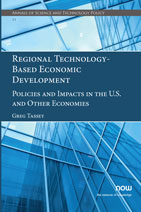Regional Technology-Based Economic Development: Policies and Impacts in the U.S. and Other Economies
By Gregory Tassey, Economic Policy Research Center, University of Washington, USA, gtassey@outlook.com
Abstract
The complexity of new technologies is forcing economies to (1) address an increasing scale and especially scope of the research and development (R&D) required to develop them, (2) capture the co-location synergies inherent in multidisciplinary and capital-intensive research processes, and (3) provide greater support for production scale-up and other commercialization investments needed to penetrate global markets. These policy imperatives are driving a regional focus for technology-based economic development (TBED) strategies in order to focus investments in technology, facilities, hardware and software, labor skills, and supporting technical infrastructures and thereby achieve both the economies of scale and scope needed to compete with increasingly aggressive national programs across the industrialized world.
A critical characteristic of these regional TBED strategies is an elaborate technical and economic infrastructure, including research consortia based around major universities, technology incubators and accelerators to support startups and entrepreneurs, community college curricula focused on training laboratory and manufacturing technicians, and ample supplies of risk capital at each phase of a technology’s development. Investment in such regional ecosystems is shown to produce significant economic benefits in the form of higher profits and substantially higher worker incomes.
To design and manage these strategies, a “technology element” framework is presented to illustrate the range of policy instruments used by governments to promote growth over a technology’s development cycle. This approach shows policy makers where in the TBED life cycle different policy instruments should be applied and how to assess the results. A comprehensive index of these high-tech inputs is applied to indicate the economic impacts.
The major policy tools are described in terms of (1) their economic rationales (i.e., the market failures that require their use); and, (2) the specific elements of each policy mechanism and how they are intended to remediate targeted underinvestment gaps at various phases of a technology’s development.
Examples of state government implementations of TBED policy mechanisms are presented to indicate the various ways they can be constructed and integrated into a regional TBED ecosystem. In the last part of the monograph, the evolution and impacts of regional TBED policies in other industrialized nations are described and compared with U.S. experiences.
The analysis finds a wide variation in overall levels and scope of investment in TBED across states and significant differences in the structure and integration of individual policy instruments, emphasizing the need for a systematic, consensus policy framework.
The major policy messages are (1) regional TBED is becoming the main driver of economic growth in industrialized nations, (2) most nations are expanding their TBED investments, and, (3) the U.S. economy lacks a comprehensive national strategy implemented through an institutionalized TBED policy infrastructure, which is placing too great a burden on individual state programs. Learning, achieving scale and scope effects, and simply increased investment need national government support.
Regional Technology-Based Economic Development: Policies and Impacts in the U.S. and Other Economies
Regional Technology-Based Economic Development: Policies and Impacts in the U.S. and Other Economies describes the economic rationales, policy elements, implementation mechanisms, and expected economic impacts of “technology-based economic development” (TBED) strategies that are being pursued in almost all 50 states within the U.S. economy.
Once the dominant leader in the development and commercialization of technology, the United States has failed to respond to this globalization trend with comprehensive TBED strategies. At the national level, a comprehensive “innovation policy” structure does not exist. This situation has left state governments with the daunting task of constructing and implementing their own TBED strategies. Such efforts are rapidly expanding, but with uneven results due to the difficulty in developing and managing the set of instruments comprising the required policy ecosystem.
Section 1 assesses the economic trends that provide the rationales for the range of policy initiatives occurring at the state level. In section 2, individual policy mechanisms and options for their integration into a holistic TBED ecosystem are described and critiqued. Section 3 describes similar TBED investment efforts in European and Asian economies. Distinct differences in the structure of and relative emphasis on individual policy tools are analyzed relative to U.S. trends.

Must Read: An Economist’s Argument for TBED , by Mark Skinner, SSTI Review